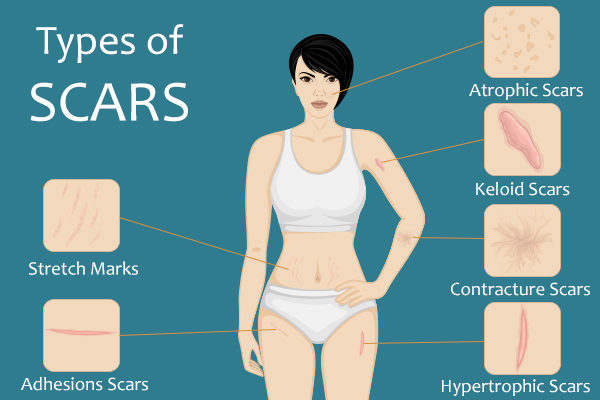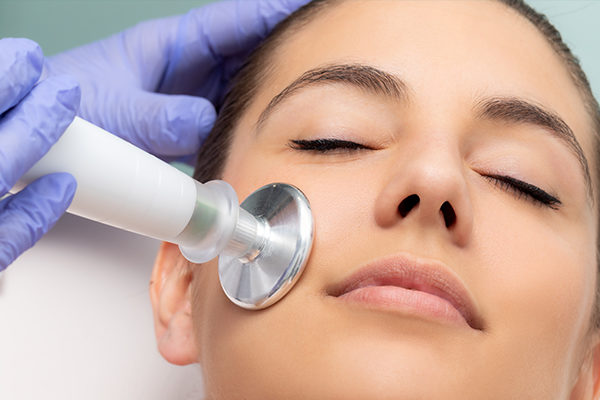In this article:
Scars refer to visible marks on the skin that appears upon the healing of an injury or wound. They are typically formed through an increased amount of normal collagen, as a part of the natural healing process.

Scars start as reddish to pink and fade with time, turning into a color darker or lighter than your skin. The type of scar depends on the injury, location of the scar, skin type, age of the person, their nutritional status, inherited scarring tendency, and many other factors.
The most common causes of scars include surgery, infections, and injury. Preventing wounds can help avoid scar formation.
How Common Are Scars?
Scars are quite common, with approximately 100 million patients per year in developed countries. Most of these scars cause complications, requiring 55 million elective operations and 25 million post-trauma operations. (1)
Types of Scars
Scars may develop anywhere on the body and can vary largely depending on their composition. They have different types, including:

1. Keloid scars
Excessive collagen production, which continues even after wound healing, leads to tissue overgrowth above skin level and is known as keloid scars. Keloid scars are initially purple or red and gradually fade over time. They are itchy and painful and may restrict movement when near a joint.
2. Contracture scars
Contracture scars are generally formed due to an injury that causes significant tissue loss, such as burns or injury to the joints. The skin and underlying tissue pull together for healing, often restricting movement.
3. Hypertrophic scars
Hypertrophic scars appear on the wound site in raised, thick, discolored clusters. Generally, they are uncomfortable and red, often widening with time.
4. Atrophic scars
Atrophic scars develop below the skin surface, producing a sunken appearance. They become more prominent with time due to aging. The most common causes of atrophic scars are chickenpox and severe acne.
5. Stretch marks
Striae, or stretch marks, are formed due to breaks in the connective tissue, caused by rapid shrinking or growing of the skin. It is common with rapid weight loss, adolescence, pregnancy, and bodybuilding.
6. Adhesions
Adhesions are scars that can develop between unjointed internal organs. They often create problems during surgery.
7. Acne scars
Pimples or acne are due to the clogging of skin pores by dead skin cells and oil, enabling bacterial growth and pus formation. When not healed properly, the pimples can form scars.
What Causes Scars?
Scars are primarily the result of the natural healing process, wherein the body produces collagen to help repair the broken tissues. A dry crust, or scab, forms over the wound for protection. The scab falls off upon healing of the wound to reveal repaired skin, often along with a scar.
Symptoms of Scars
Symptoms associated with scar formation include:
- Soreness
- Itching or pricking
- Redness
- Bumps on the skin
- Restricted movement of the body
Medical Treatment for Scars

Various treatment options can help treat abnormal scars. (2)
1. Surface treatment
Also known as skin resurfacing procedures, these treatments help remove the damaged skin layer, making way for new and healthy skin to form:
- Dermabrasion: This procedure uses an electric machine for scraping the top layer of skin to reveal new, healed, and smoother skin. It is commonly used for minor irregularities in the skin surface, small scars, acne scars, and surgical scars.
- Chemical peels: This treatment helps reduce sun damage, superficial scars, and irregular pigmentation of the skin with the use of chemicals that aid in the removal of the surface layer of the skin.
- Laser resurfacing: Focused light is used generally to reduce the appearance of acne scars. It can be performed using wounding/ablative lasers that remove the top layer of the skin or non-wounding/non-ablative lasers that work by inducing collagen production.
2. Injection treatment
Three different types of injections are used for reducing scar appearance:
- Dermal fillers: These injections can be used to plump up depressed scars and include semi-permanent fillers, synthetic solutions, and hyaluronic acid.
- Cortisone injections: Corticosteroids are directly administered into a keloid or hypertrophic scar to help reduce its size by breaking the collagen fibers. Additionally, their anti-inflammatory properties aid in reducing swelling, itching, tenderness, and redness.
- Collagen injections: These injections are used to temporarily fill in the sunken areas with collagen, a natural protein. It is vital to ensure that you are not allergic to collagen before undergoing this treatment.
3. Surgery
Different surgical interventions can treat major scars, which include:
- Cryosurgery: The surface layer of the skin is frozen with liquid nitrogen to help reduce the size of the scar or remove superficial skin lesions such as actinic keratosis.
- Punch grafts: Scarred skin is replaced with small skin grafts to treat deep acne scars.
- Surgical scar revision: A scar formed due to improper healing or other circumstances may be removed using plastic surgery techniques, repaired under local anesthesia, and then allowed to re-heal in a controlled way.
4. Radiation therapy
If the scar is resistant to other therapies, radiation may be used.
Diagnosing Scars
Identifying the cause and type of scar is essential in determining the appropriate treatment and management of the scar.
The diagnostic procedure for most scars involves a simple physical exam involving visual inspection and palpation, especially for keloids and hypertrophic scars. (3) However, the doctor may suggest a biopsy if the cause of the scar is unknown, or it has an unusual shape.
Also, get your scars checked by a dermatologist as, rarely, scars may look similar to skin cancer, especially scars that develop without any injury or wound. In such cases, the doctor may suggest imaging diagnostic tests, such as MRI, CT, or ultrasound, and a biopsy for confirmation.
Side Effects of Scars
The development of scars may produce some side effects, including:
- Pain
- Tenderness
- Severe itching
- Anxiety or depression due to self-consciousness
- Disturbed sleep
- Hampered daily routine
- Infection
- Redness
- Cracks in the skin
Risk Factors for Developing Scars
Certain factors increase the chances of developing scars, including:
- Latin, Asian, or black ethnicity
- Age above 30 years
- Pregnancy
- Being a teenager
- History of scars in the family
- Medical conditions such as epidermolysis bullosa and hidradenitis suppurativa
Complications Associated With Scars
Often, scars can lead to the development of:
- Skin sensitivity
- Skin discoloration
- Swelling
- Skin contour irregularities
- Persistent pain
- Deep vein thrombosis
- Cardiac and pulmonary complications
- Problems with vision, feeding, and speech (if the scar is near the eyes or mouth)
At times, the scars may continue to grow beyond the scar margins and may even reappear after excision.
When to See a Doctor
It is advised to seek medical help if you have:
- A skin type that scars easily
- History of problematic scarring
- Delayed wound healing (more than 3 weeks)
Final Word
Scars develop as part of wound healing and often fade with time. Therefore, treatment is not always necessary if the scar is not producing any complications to your health.
However, if you are bothered by your scar or are self-conscious of it, talk to your parents or doctor for enlightenment, guidance, and treatment.

- Was this article helpful?
- YES, THANKS!NOT REALLY


